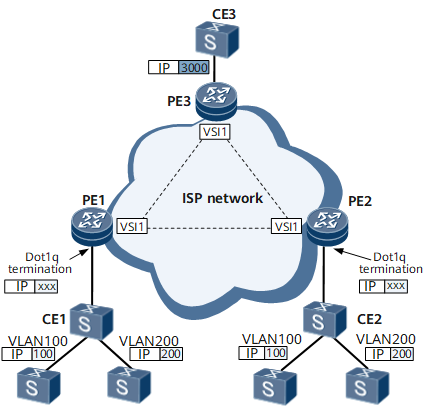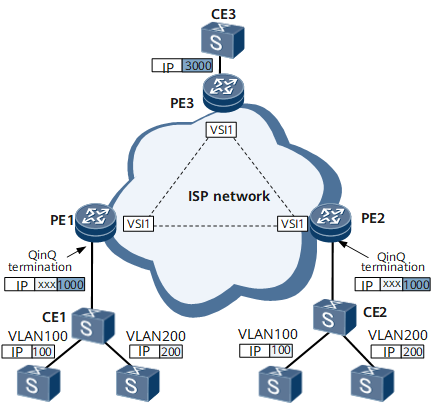VPLS Access Through a Termination Sub-interface
Virtual private LAN service (VPLS) access through a termination sub-interface means that VPLS functions are configured on the termination sub-interface. By configuring the range of double VLAN tags on the sub-interface for QinQ VLAN tag termination of the PE, a local Virtual Switching Instance (VSI) can communicate with a remote VSI. VPLS access is often used for communication between QinQ users of Layer 2 enterprise networks.
On a VPLS network, one Virtual Circuit (VC) link connects only a user's two VLANs that are distributed in different places. If the user wants to connect multiple VLANs distributed in different places, multiple VCs are required.
As a termination sub-interface supports a VLAN range, configuring VPLS access through a termination sub-interface allows one VC to connect users in the VLAN range. Traffic of all the VLANs in the specified range is transmitted over this VC, greatly saving VC resources of the public network and configuration workload. In addition, users can plan their own VLANs, irrespective of what the Internet Service Provider's (ISP's) VLANs are.
VPLS functions can be configured on a sub-interface for Dot1q VLAN tag termination or sub-interface for QinQ VLAN tag termination, based on whether the user packets received by a PE contain one or two VLAN tags.
If the user packets contain one tag, the sub-interface that has VPLS functions configured is a sub-interface for Dot1q VLAN tag termination.
If the user packets contain double tags, the sub-interface that has VPLS functions configured is a sub-interface for QinQ VLAN tag termination.
VPLS Access Through a Sub-interface for Dot1q VLAN Tag Termination
Figure 1 shows a typical networking for VPLS access through a sub-interface for Dot1q VLAN tag termination.
VPLS supports the Point-to-Multipoint Protocol (P2MP) and forwards data by learning MAC addresses. In this case, VPLS access through a sub-interface for Dot1q VLAN tag termination can be performed by MAC address learning on the basis of a single VLAN tag. Note that there are no restrictions on VLAN tags for VPLS access.
VPLS Access Through a Sub-interface for QinQ VLAN Tag Termination
Figure 2 shows a typical networking for VPLS access through a sub-interface for QinQ VLAN tag termination.
VPLS supports the P2MP and forwards data by learning MAC addresses. In this case, VPLS access through a sub-interface for QinQ VLAN tag termination can be performed by MAC address learning on the basis of double VLAN tags. Note that there are no restrictions on VLAN tags for VPLS access.

